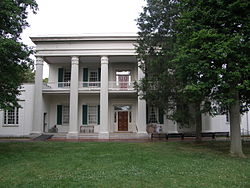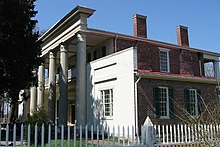The Hermitage (Nashville, Tennessee)
|
The Hermitage | |
 | |
|
The Hermitage | |
| Location: | 4580 Rachel's Ln Nashville, TN 37076 |
|---|---|
| Coordinates: | 36°12′53.9″N 86°36′46.7″W / 36.214972°N 86.612972°W / 36.214972; -86.612972Coordinates: 36°12′53.9″N 86°36′46.7″W / 36.214972°N 86.612972°W / 36.214972; -86.612972 |
| Area: | 350 acres (140 ha)[1] |
| Built: | 1835 (current form) |
| Architect: | Reiff & Hume |
| Architectural style: | Greek Revival |
| NRHP Reference#: | 66000722 |
| Significant dates | |
| Added to NRHP: | October 15, 1966 |
| Designated NHL: | December 19, 1960[2] |
The Hermitage is a historical plantation and museum located in Davidson County, Tennessee, USA, 10 miles (16 km) east of downtown Nashville. The plantation was owned by Andrew Jackson, the seventh President of the United States, from 1804 until his death at the Hermitage in 1845. Jackson only lived at the property occasionally until he retired from public life in 1837. It is a National Historic Landmark.
Contents[show] |
[edit] History
The plantation that Jackson named Hermitage was ideally located 2 miles (3.2 km) from the Cumberland and Stones rivers; the land was originally settled by Robert Hays, grandfather to legendary Texas Ranger John Coffee Hays and Confederate General Harry Thompson Hays in 1780. Hays sold the 420-acre (170 ha) farm to Jackson in 1804.[3] Jackson and his wife Rachel moved into the existing two-story log blockhouse, built to resist Indian attacks. After Jackson built the main house, it was disassembled and rebuilt as two one-story buildings used as slave quarters; a part of it still stands behind The Hermitage.[4] Initially Jackson operated the cotton farm with nine African slaves, but this number gradually grew to 44 slaves by 1820 as the farm expanded to 1,000 acres (400 ha).
The original Hermitage mansion was a two-story, eight-room, Federal-style brick building built with skilled slave labor and completed between 1819 and 1821. In November 1828, Jackson was elected 7th President of the United States; however, his wife Rachel died the following month. In 1831, while Jackson was away in the White House, he had the mansion remodeled with flanking one-story wings (one with a library and the other with a large dining room and pantry), a two-story entrance portico with Doric columns and a small rear portico. Jackson also had a classicising “temple & monument” for Rachel's grave constructed in the garden. Craftsmen completed the domed limestone tomb with a copper roof in 1832. In 1834, a chimney fire seriously damaged all of the building with the exception of the dining-room wing. This prompted Jackson to have the current Greek Revival structure built, which was completed two years later. The carpenter contractors were Joseph Reiff and William C. Hume, who were constructing Tulip Grove across the road. The entry hall is decorated with block-printed wallpaper by Joseph Dufour et Cie of Paris, depicting scenes from Telemachus' visit to the island of Calypso.[5] Many of Jackson's furnishings and mementos are preserved in the house, which was guarded by Union troops during the Civil War, as it had been sold to the State of Tennessee by Andrew Jackson Jr. in 1856.
On May 5, 1863, units of the Union Army, specifically those from Indiana, approached the grounds of the Hermitage. Pvt. Joseph C. Taylor wrote of the account in his diary.
| “ | At 2 this morning Co.'s according to previous agreement, saddled up and started for a big scout. About daylight we arrived at Stone River. Colonel McCook was with us. We used great caution while crossing the river. We formed a line of battle and crossed a Company at a time, forming a line on the opposite side. We all crossed in safety, and proceeded to the Hermitage of General A. Jackson, where we halted for a while. Thin by orders of the Colonel went to see the hermitage also the tomb of General A. Jackson. I will describe the place as well as I can. There is a nise gravel road from the Main road to the house. on each side of this mall there is a nise row of large cedar trees, which almost darken the passage as the branches meet overhead. When in 20 steps of the front door, this road forks and directly in front is a space in the shape of a heart. Around this the road runs, which enables the carriage to come up to the door. This heart is enclosed by a similar row of cedars. The inside of this heart, and also on each side of the carriage way is thickly set with pines, cedars and other shrubbery of long standing, which almost excludes the sun shining on the ground. There is nise gravel walks leading to every place that a person want to go. From appearances those walks are but little used, as the grass is growing in the walks to some extent. We then went in the garden which is situated on the East of the house. Which is between the house and the Lebanon Pike, and is full of shrubbery and flowers of all kinds. Also walks running in all directions which beautifies the place and also give it a cold look to me, as I never saw a garden arrainged in this fashion. In the South East corner of this garden stands the monument of General Andrew Jackson. General Jackson lays on the South side of the tomb. His head in the direction of West, his feet to the East. His wife lays on the North and 2 infant children lay on the South of the tomb. It is all together a dark and secluded spot and looks to me as though it was verry old fassion." | ” |
|
—Pvt. Joseph C. Taylor, Co. I, 2nd Indiana Cavalry[6] | ||
In 1889, the Hermitage was opened to the public as a museum, both of Jackson's life and the antebellum South in general. Each year, the home receives more than a quarter million visitors, making it the fourth most-visited presidential residence in the country (after the White House, Mount Vernon, and Monticello). The property was declared a National Historic Landmark in 1960.[1][2][7]
The tomb of Andrew and Rachel Jackson is located in the Hermitage garden.
It escaped a near-disaster during the 1998 Nashville tornado outbreak. An F-3 tornado crossed the property at approximately 4:00 p.m. CDT on April 16, 1998, missing the house and gravesite, but toppling many trees that had reportedly been planted by Jackson himself nearly 200 years earlier. Although the trees had once hidden the house from view of passers-by on U.S. Route 70, it is now in plain sight. Using the wood from the fallen trees, the Gibson guitar company produced 200 limited edition "Old Hickory" guitars. The first guitar produced was presented to the Smithsonian. It is not currently on display. [8]

[edit] The Hermitage as namesake
The area of Davidson County surrounding the Hermitage is known as Hermitage, Tennessee. A hotel named the Hermitage Hotel, located in downtown Nashville, Tennessee opened in 1910, and is still operating. Many celebrities and U.S. Presidents have spent time there.[9]
[edit] In popular culture
The Hermitage was one of the filming locations and settings for the 1955 Disney film Davy Crockett, King of the Wild Frontier.
The plantation is prominently featured in one of the opening scenes of F. Scott Fitzgerald's unfinished novel, The Love of the Last Tycoon (1941), when the narrator, Celia, visits it with two other characters
'Tennessee' 카테고리의 다른 글
| Andrew Jackson (0) | 2013.04.06 |
|---|---|
| Crossville, Tennessee (0) | 2013.04.06 |
| Andrew Johnson (0) | 2013.04.05 |
| Nashville, Tennessee (0) | 2013.04.05 |
| Battle of Shiloh (0) | 2013.04.03 |

